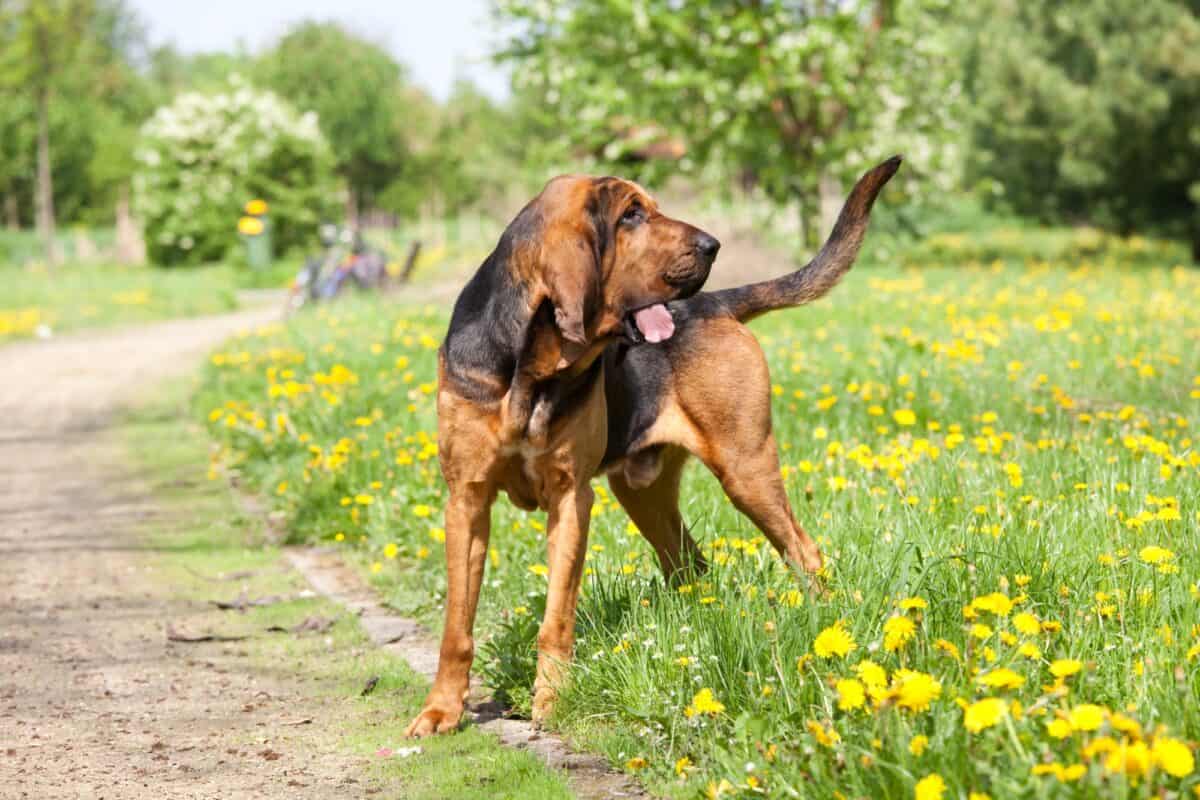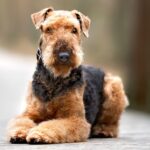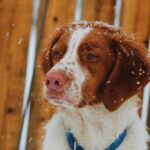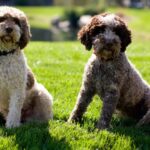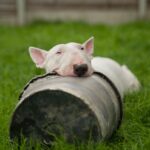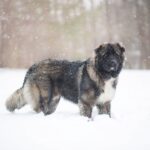Here is a concise but comprehensive list of information about bloodhound puppies. Please read this post before visiting shelters or rescue organizations if you want to adopt a bloodhound puppy.
In medieval France, the forerunners of the Bloodhound were developed to track deer and boar. This breed of dog is incredibly intelligent and active today, and their keen sense of smell has earned them a special place in law enforcement and search and rescue. They are adored by their fans for their charming personalities and distinctive looks.
About This Breed
Although the Bloodhound has been bred and developed in Britain since before 1300, it may be related to hounds once housed at the Belgian monastery of St. Hubert. He was instrumental in saving the French Chien de St. Hubert from extinction in the 19th century, and he still goes by that name in some parts of Europe.
He was first employed as a leashed hound for the hunting of deer and wild boar, but he was also used from the very beginning to track people. Up until about 1600, he was employed on both sides of the Scottish border to hunt down cattle thieves and raiders. In Scotland, he was known as the sleuth-hound.
Health
Bloodhounds are susceptible to bloat like other big, deep-chested dogs. Owners of bloodhounds should become knowledgeable about the signs of this potentially fatal condition so they can take the necessary precautions.
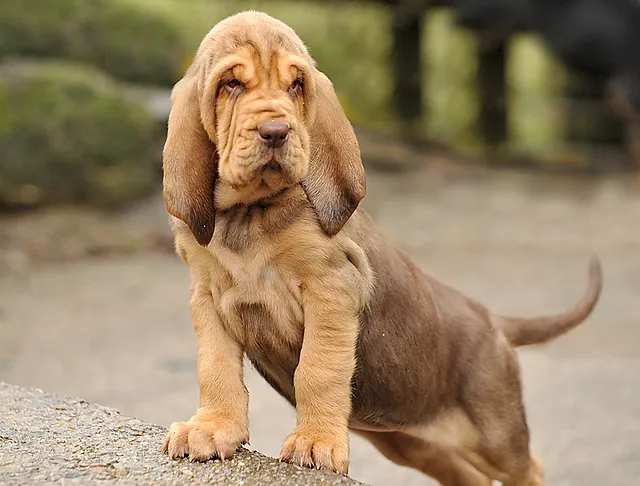
Bloodhounds are known for consuming anything and everything, which frequently results in trips to the veterinarian. Daily inspection is recommended for any infection in the Bloodhound’s low-hanging ears.
Additionally, check the Bloodhound’s skin folds every day for odor or irritation; if necessary, wipe with a warm, wet cloth and then completely dry. A Bloodhound should have regular dental care, just like other breeds.
Personality
A study in inconsistencies is The Dignified Bloodhound. He is obedient but obstinate, determined but not argumentative, and affectionate but a little reserved around strangers. He’s sensitive to kindness or correction when it comes to training, but he still prefers to do things his way.
He has a keen nose for finding even the smallest signs of a trail, but given his affection for people, he makes a poor watchdog or guard dog. Some Bloodhounds are vocal and will bark a lot when they are excited. The others are peaceful.
Many things, including upbringing, education, and socialization, have an impact on temperament. Puppies with good temperaments are playful and inquisitive, and they are eager to approach people and be petted. Instead of picking the aggressive or corner-hiding puppy, go with the middle-of-the-road pup.
Always meet one or both of the parents to make sure you get along with them. Usually, the mother is the one who is available. A puppy’s future traits can be predicted by meeting his siblings or other family members.
Bloodhounds need early socialization or being exposed to a wide variety of people, sights, sounds, and experiences, when they are young, just like all dogs do. Your Bloodhound puppy’s development into a well-rounded dog is aided by socialization.
The best place to begin is to sign him up for puppy kindergarten. Regularly hosting guests, taking him to crowded parks, and dog-friendly shops, and on leisurely strolls to meet neighbors will all help him hone his social skills.
Grooming
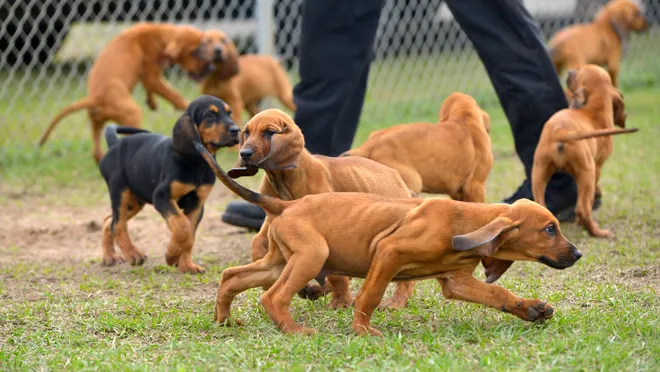
The short, dense coat of the Bloodhound is shed once or twice a year. The dead hair can be removed before it lands on the furniture by giving your dog a weekly brushing with a medium-bristle brush, a rubber grooming tool or mitt, or a hound glove.
Additionally, brushing encourages the growth of new hair and distributes skin oils throughout the coat to keep it healthy. To prevent them from smelling like a dog, bloodhounds should be bathed frequently. Regular nail trimming is necessary for all breeds, including the Bloodhound.
Feeding
4 to 8 cups of superior dry food should be consumed every day, split between two meals.
NOTE: The amount of food your adult dog consumes depends on his size, age, build, metabolism, and level of activity. Like people, dogs are unique creatures with different nutritional needs. A highly active dog will require more than a couch potato dog, which should almost go without saying.
The kind of dog food you buy also matters; the better the food, the more effectively it will nourish your dog, and the less you will need to shake into the bowl.
Instead of leaving food out all the time, feed your Bloodhound twice a day using a measuring cup. Give him the hands-on and eye tests if you’re unsure whether he’s overweight.
Look down at him first. There ought to be a waist visible. Then lay your hands on his back with your fingers spread out and your thumbs along his spine. Without exerting much pressure, you ought to be able to feel his ribs but not see them. If you can’t, he needs to eat less and exercise more.
You might want to cover the ears with a snood before feeding a bloodhound because they have messy mouths. To avoid the ears dragging in the water dishes, choose ones with a small diameter.
Gastric torsion, or bloat, is a problem for bloodhounds. Large meals followed by a lot of water consumption, strenuous activity right before or after a meal, feeding babies from raised feeding dishes, and stress are all causes of bloat. When you feed your Bloodhound, bear these things in mind.
Exercise
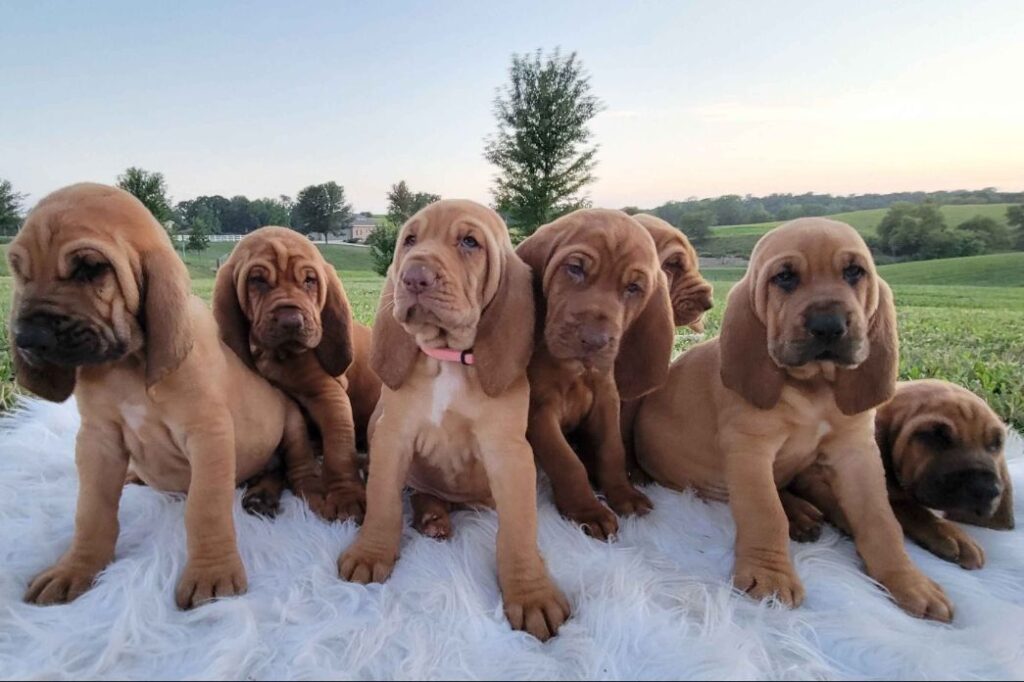
The common misunderstanding is that Bloodhounds spend their days lounging on the front porch. The Bloodhound is an active dog that needs daily exercise because they were bred to follow a scent for extended periods of time. Long daily walks on a leash are in his best interest because if he has found a scent to follow, he might not listen to commands.
Since Bloodhounds are excellent diggers and escape artists, the additional exercise time can be obtained in the backyard, which must be securely fenced.
Training
Like with all breeds, it is advised to start early socialization and puppy training. It’s best to start obedience training early with a Bloodhound because they have a tendency to develop lifelong habits. It’s best if the habits they adopt are the ones their owner wants them to have.
An owner must be firm yet kind because bloodhounds like to be in charge. Positive reinforcement in the form of treats and praise is typically effective during training. The Bloodhound requires persistence, patience, and skill during training because he is affectionate and devoted but also independent and stubborn.
Children and Other Pets
Children are dear to bloodhounds. Nevertheless, given their size and activity level, they have the potential to accidentally knock a child to the ground with a swipe of the tail. They work best in homes with older kids.
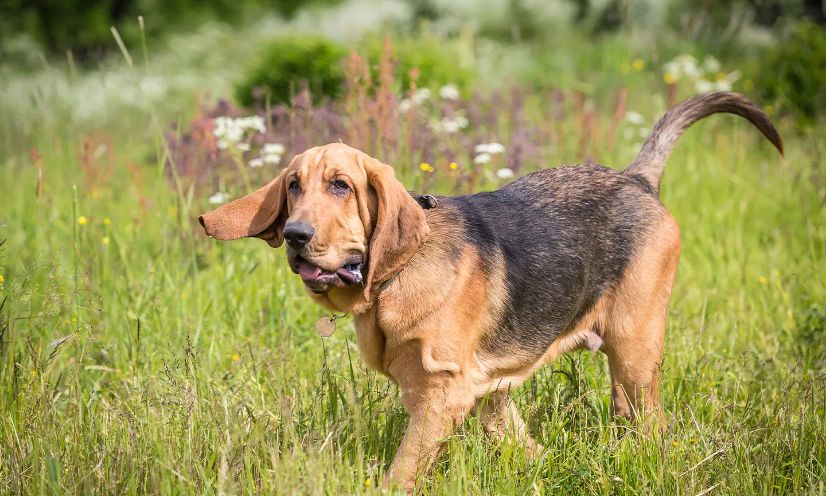
Always supervise any interactions between young children and dogs to prevent biting or ear or tail pulling on either party’s part, and always teach kids how to approach and pet dogs. Teach your child not to approach any dogs while they are sleeping or eating, or to try to take the food from the dogs. With a child present, no dog should ever be left unattended.
Though some Bloodhounds have issues with small dogs, in general, they get along well with other dogs. Although your cat might not like being slobbered on, they typically get along just fine with cats.
History
The bloodhound has a lengthy and honorable past. It was St. in the seventh century who refined the breed. Belgian Hubert and his monks. Since then, these canines have frequently been linked to the aristocracy.
Modern bloodhounds are descendants of the bloodhounds William the Conqueror brought to England in 1066. He brought several bloodhounds with him. While this was happening, St. Every year, Hubert’s monastery continued to give the King of France a pair of black and tan bloodhounds.
These dogs still go by the name St. in French-speaking regions of Europe. Hubert hounds.
Initially, deer and other types of game were tracked with bloodhounds. But by the 16th century, they were also being used to follow people. Bloodhounds now help with both search and rescue operations and law enforcement. Bloodhounds that have proven themselves to be excellent trailers can be used as witnesses in court because of their skills.
Here are some other dog breeds information for you.

